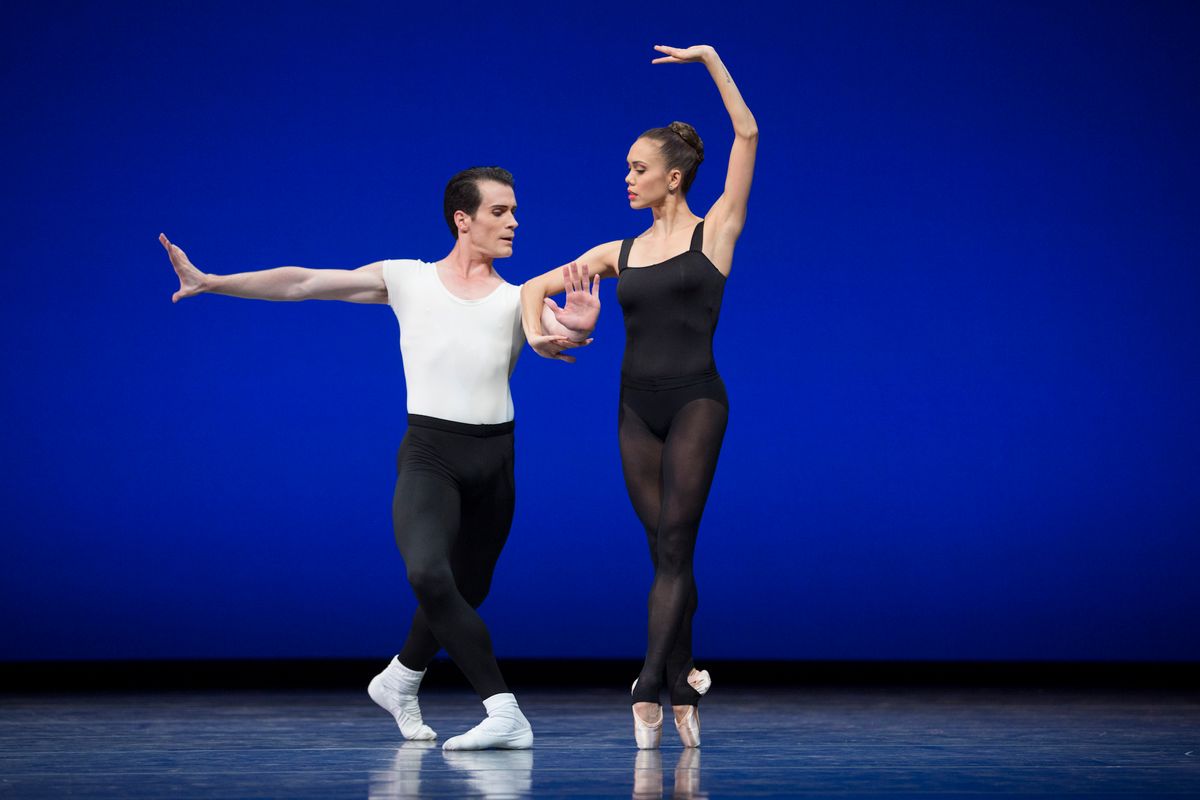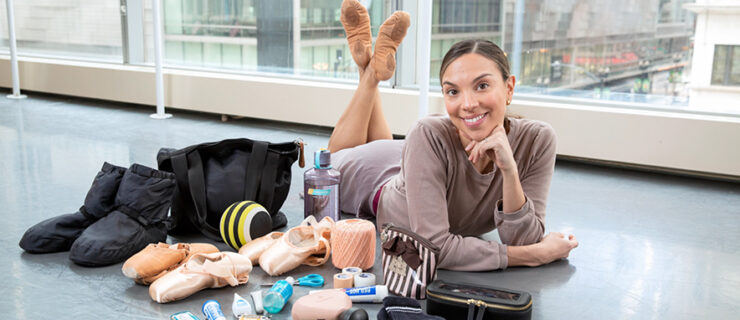The Secrets to a 20-Year Career: How 3 Dancers Maintain Their Technique, Stay Inspired and More
It’s rare for a professional ballet career to extend two decades or more. But there are indeed dancers who’ve been gracing the studio and stage for that long—learning, adapting and growing along the way. Today, Pacific Northwest Ballet’s Noelani Pantastico, National Ballet of Canada’s Guillaume Côté and Ballet Memphis’s Crystal Brothers reveal what physically, artistically and emotionally sustains their careers.

Ballet Memphis’ Crystal Brothers in Mark Godden’s “Firebird.” Basil Childers, Courtesy Ballet Memphis.
What physically helps you sustain your career?
Guillaume Côté:
Cross training—I like Gyrotonics, it helps balance and stretch everything out. I also like cardio. And, of course, just good old-fashioned ballet class, though you do have to work harder as you get older.
Crystal Brothers:
I have an extensive regime; what worked for me at 19 doesn’t work for me at 42. I take a hot bath as soon as I wake up. Then I ice my feet, work out on an exercise bike while I do my makeup, and do Pilates mat and reformer. After that, I take another hot bath. When I get to the studio, I do a full barre on my own before company class.
Noelani Pantast
ico:
What really helped me was joining Les Ballets de Monte-Carlo in Monaco for 7 years. It gave me all of these tools for my toolbox. We would have teachers give class for 2-3 weeks solid. They proposed different options and approaches to technique. I’ve likewise learned to listen to my body; it tells me something different each day. When my repertoire changes, I change the way I approach company class, adapting it for my needs.

Guillaume Côté in Balanchine’s “Apollo.” Cylla von Tiedemann, Courtesy NBoC.
What mentally and emotionally helps you sustain your career?
GC:
I’m always setting goals and expectations. For instance, I’ve been preparing the title role in Balanchine’s Apollo. When I look at Apollo now, it’s about making it new again, the way I’d dance it at 37, not 21. I’m also inspired by the new company members. You know they say: If want your old dog to feel young, you get a new dog.
CB:
Teaching helps me. It’s humbling, helps me focus on others and obsess less on myself. Another thing is wearing colorful outfits, wearing sparkly things in my hair and wearing lipstick—I like to dress the part of the character I’m working on. I’m also sustained by helping other dancers, laughing at myself, and puppy snuggles—I have two dogs named Miss Whittle and Miss Bella.
NP:
I go into the studio every day as a new dancer. There’s a parallel between the physical and emotional demands of dance, you feel things out. If I’m feeling overwhelmed, I’ll take some time for myself. But I don’t think so much think of sustaining a dance career, I think of dance as sustaining me. As a kid, I had a lot of anxiety, and dance saved me.

Noelani Pantastico in Jean-Cristophe Maillot’s “Roméo et Juliette. Angela Sterling, Courtesy PNB.
How has your technique evolved over time?
GC:
The logistics—I’ve had a major knee surgery and a herniated disc, so I have to work with that. I also feel like I wasted so much energy when I was younger. There are rules you can give 140 percent to, but they won’t necessarily resonate with an audience. I now have a better understanding of what reads onstage—things like musicality and being true to the geography and intent of the choreography. It’s about finding the right things to emphasize.
CB:
I think that it’s been about learning to dance in cursive: making it look like music is coming from my body, timing, and connecting an ending to a beginning. I try to “tell the truth” at the barre, which means that even if I’m not in the most perfect line, I’m still working on stability and longevity. I also have an established trust with my company of 23 years and this allows me to take responsibility for my warm-up process. If I need to do two-footed jumps until I feel warm, I will.
NP:
I’m blessed to have trained at Central Pennsylvania Youth Ballet and I continue to rely on that foundation. When I left PNB for Les Ballets de Monte-Carlo, I started to make some subtle changes. There is a more pedestrian approach that is vital to Jean-Christophe Maillot’s work. A guest teacher there helped me realize how to maximize and manage a fuller range within my work. A lot of things, such as my contemporary work, felt better, but there were things I lost in the mix too, like multiple pirouettes. When I returned to PNB, I worried that I wouldn’t be the same technical dancer that I was known to be before. But I’ve continued to rely on my CPYB training and have it layered with all I’d attained in Monte-Carlo. I’m more confident now that I can access whatever I need for whatever kind of dancing I am asked to do.

Guillaume Côté. Karolina Kuras, Courtesy NBoC.
How has the artistic side of your dancing evolved?
GC:
It’s evolved a lot. I’ve choreographed for 15 years and studied music composition at the University of Toronto. I like to see the similarities between music composition and choreography. I now look at ballets from the outside—the architecture, how it all fits together. You can give your best show, but the ballet is a whole, not just one role.
CB:
Early in my career people would say things like I’m a “feisty technician.” But, there were roles that helped break me open: exploring the light and dark in Swan Lake as Odette/Odile, doing Giselle’s mad scene, and portraying the contrasting Wicked Witch and Glinda in The Wizard of Oz. I’ve also done Juliet twice; the second time was just months after my husband passed away. In experiencing low lows, you also understand that you’ve experience high highs. You bring your life experiences to the stage, and the colors on your wheel well increase.
NP:
At this point, it’s the most important part. Jean-Christophe Maillot’s Roméo et Juliette, in particular, helped me grow as an artist. Working closely with him helped me see not what I was doing, but what the audience was seeing. The older you get, the more you experience. I like to feel things, so I like to make people feel things too. I love getting to be someone else. I’ve likewise learned to allow myself to be vulnerable onstage. Being vulnerable is strength.

Crystal Brothers in Mark Godden’s “Midsummer Night’s Dream.” Andrea Zucker, Courtesy Ballet Memphis.
What keeps you inspired?
GC:
The constant challenge and being part of something greater than myself. I don’t know if we’re changing the world, but I like to think we’re making it a better place.
CB:
One of my favorite things is being able to take pictures with audience members after shows. I love seeing people of all ages mesmerized and inspired by dance. There’s a feeling the magic in the air. I’ve worked hard in ballet, but I’ve also been presented with amazing opportunities. I believe in magic, I believe in fairies—I have to perform. It’s truly a dream come true.
NP:
Revisiting roles and rediscovering myself in them, like last year when I got to dance Odette/Odile again after 10 years. I’m also motivated by the young members of the company. Their generation can get a bad rap, but I don’t see that at all. They are hardworking and inspiring.





